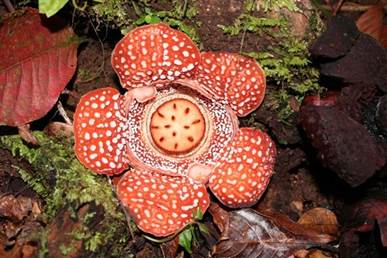植物何时将不再是植物?
作者:Jeanmaire Molina等; David Roy Smith等
时间:2014-03-24

叶绿体令植物特别,其给植物绿色,转化阳光(能量)为糖,进行各种其他重要的化学过程;叶绿体甚至有自己的DNA。
所以,两项新研究震憾植物群落:研究人员发现两种植物已经遗弃了使叶绿体运作的遗传信息。第一,大王花(Rafflesia lagascae),有时因为它的味道而称为“尸体草”,是一种以热带藤本葡萄树为生的寄生植物。研究人员本月《分子生物学与进化》中报告它已完全失去叶绿体基因组。
第二个遗失叶绿体DNA的是四种Polytomella藻。Polytomella是一种非寄生的单细胞植物,从其生活的淡水中获得食物。像大花草一样,这个藻类仍有所谓的质体,即叶绿体壳,但没有使其成为绿色的叶绿素。通常,质体依靠自己的DNA。但深入细致的四种藻类DNA测序并没有发现任何质体DNA,藻类的主要基因组中也没有任何通常用于维持质体基因组顺利运行的基因。
其他研究人员进行大花草属所有DNA测序时,证明了研究的真实性。那个团队发现叶绿体基因残遗物,但这些基因片段属于这种寄生植物赖以为生的热带藤本葡萄树。双方都认为:一旦叶绿体失去其主要功能光合作用,叶绿体的基因逐渐解体或移进主要基因或进入另一个细胞成分线粒体的基因组,从而无需叶绿体基因组。(编译:中国科学院成都生物研究所 王芋华,王海燕)
Possible loss of the chloroplast genome in the parasitic flowering plant
Rafflesia lagascae (Rafflesiaceae)
Abstract Rafflesia is a genus of holoparasitic plants endemic to Southeast Asia that has lost the ability to undertake photosynthesis. With short-read sequencing technology, we assembled a draft sequence of the mitochondrial genome of Rafflesia lagascae Blanco, a species endemic to the Philippine island of Luzon, with ∼350x sequencing depth coverage. Using multiple approaches, however, we were only able to identify small fragments of plastid sequences at low coverage depth (< 2x) and could not recover any substantial portion of a chloroplast genome. The gene fragments we identified included photosynthesis and energy production genes (atp, ndh, pet, psa, psb, rbcL), ribosomal RNA genes (rrn16, rrn23), ribosomal protein genes (rps7, rps11, rps16), transfer RNA genes, as well as matK, accD, ycf2, and multiple non-genic regions from the inverted repeats. None of the identified plastid gene sequences had intact reading frames. Phylogenetic analysis suggests that ~33% of these remnant plastid genes may have been horizontally transferred from the host plant genus Tetrastigma with the rest having ambiguous phylogenetic positions (<50% bootstrap support), except for psaB which was strongly allied with the plastid homologue in Nicotiana. Our inability to identify substantial plastid genome sequences from R. lagascae using multiple approaches - despite success in identifying and developing a draft assembly of the much larger mitochondrial genome - suggests that the parasitic plant genus Rafflesia may be the first plant group for which there is no recognizable plastid genome, or if present is found in cryptic form at very low levels.
原文链接:http://mbe.oxfordjournals.org/content/early/2014/01/23/molbev.msu051.full.pdf+html
A plastid without a genome: evidence from the nonphotosynthetic
green alga Polytomella
Abstract Polytomella is a free-living, nonphotosynthetic green alga, closely related to the model organism Chlamydomonas reinhardtii. Although colorless, Polytomella has a plastid, but it is still unknown whether it harbors a plastid genome. We took a next-generation sequencing approach, along with transcriptome sequencing, to search for a plastid genome and an associated gene expression system in Polytomella. Illumina sequencing of total DNA from four Polytomella species did not produce any recognizable plastid-derived reads, but did generate a large number of mitochondrial DNA sequences. Transcriptomic analysis of Polytomella parva uncovered hundreds of putative nuclear-encoded, plastid-targeted proteins, which support the presence of plastid-based metabolic functions, similar to those observed in the plastids of other nonphotosynthetic algae. Conspicuously absent, however, were any plastid-targeted proteins involved in the expression, replication, or repair of plastid DNA. Based on these and earlier findings, we argue that Polytomella represents the first well-supported example of a primary-plastid-bearing lineage without a plastid genome.
原文链接:http://www.plantphysiol.org/content/early/2014/02/21/pp.113.233718.full.pdf+html




